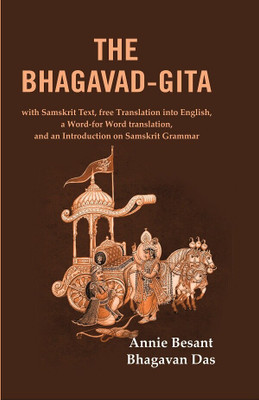The Bhagavad-Gita: with Samskrit Text, free Translation into English, a Word-for Word translation, and an Introduction on Samskrit Grammar(Paperback, Annie Besant, Bhagavan Das)
Quick Overview
Product Price Comparison
About The Book: The book delves into the Bhagavad-Gita's profound teachings across its eighteen chapters. Each chapter explores different aspects: Gita Mahatmyam: Highlights the Varaha-Purana's praise for the Gita's greatness. Gita-Karadi-Nyasah: Discusses the Tantra method for practicing the Gita. Gita-Dhyanam: Focuses on meditation to grasp the essence of the Gita. Chap: I Arjuna Vishada*Toga: Arjuna contemplates the consequences of warfare with his kinsmen. Chap: II Sankhya-Yoga: Shri Krishna advocates performing duty without attachment, emphasizing the eternal nature of the Self. Chap: III Karma-Yoga: Arjuna questions the compatibility of duty and violence, leading to a resolution. Chap: IV Jnana-Vibhaga-Yoga: Shri Krishna emphasizes wisdom and explores various yoga disciplines. Chap: V Karma-Sannyasa-Yoga: Arjuna raises doubts about renunciation versus active engagement. Chap: VI Adhyatma-Yoga: Shri Krishna elucidates the attributes of a Yogi and the consequences of failure. Chap: VII Jnana-Yoga: Shri Krishna elaborates on wisdom and the glory of the Self. Chap: VIII Akshara-Brahma-Yoga: Arjuna seeks understanding of Brahman's nature. Chap: IX Raja-Vidya-Raja-Guhya-Yoga: Shri Krishna expounds on the "Royal Secret" and devotion to the Supreme Self. Chap: X Vibhuti-Yoga: It describes the majestic manifestations of the Supreme Self. Chap: XI Vishvarupa-Darshana-Yoga: Shri Krishna unveils the interconnectedness of beings and their duty to Ishvara. Chap: XII Bhakti-Yoga: Arjuna inquires about devotion to the Unmanifested Eternal versus the manifested Ishvara. Chap: XIII Kshetra-Kshetrajna-Vibhaga-Yoga: Shri Krishna explains the distinction between Purusha and Prakriti. Chap: XIV Gunatraya-Vibhaga-Yoga: It discusses the three gunas of Prakriti. Chap: XV Purushottama-Yoga: Shri Krishna elaborates on the aspects of the Purusha. Chap: XVI Daivasura-Sampad-Vibhaga-Yoga: Shri Krishna delineates the dual nature of beings. Chap: XVII Shraddha-Traya-Vibhaga-Yoga: Arjuna seek


